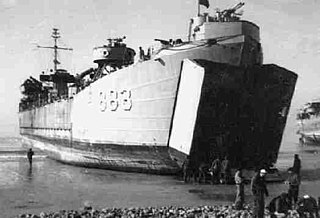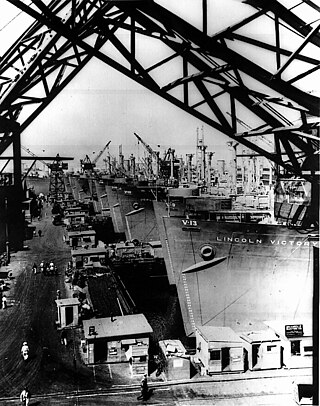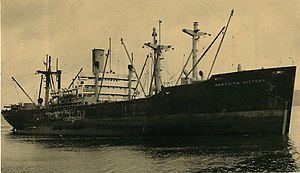
Geojedo, or Geoje Island, is the principal island of Geoje, South Gyeongsang Province, Republic of Korea. It is joined to land by two bridges from nearby Tongyeong. Gohyeon is the largest town on the island. The Busan–Geoje Bridge was opened in December 2010 and provides a more direct connection to the city of Busan.

SS Lane Victory is an American Victory-class cargo ship used in World War II, the Korean War and Vietnam War. The ship was preserved in 1989 to serve as a museum ship in the San Pedro area of Los Angeles, California. As a rare surviving Victory ship, she was designated a U.S. National Historic Landmark.

The Hungnam evacuation or Heungnam redeployment, also known as the Miracle of Christmas, was the evacuation of United Nations (UN) forces and North Korean civilians from the port of Hungnam, Hamhung, North Korea, between 15 and 24 December 1950 during the Korean War. As part of the fighting withdrawal of UN forces against the People's Volunteer Army (PVA) during the Battle of the Chosin Reservoir, they abandoned some 59,000 square kilometers of North Korean territory to enemy forces and retreated to Hungnam from where they were evacuated to South Korea.

SS Twin Falls Victory, named after Twin Falls, Idaho, was a Victory ship built for World War II. Converted to a Missile Range Instrumentation Ship, she was initially operated by the US Air Force as USAF Twin Falls Victory, before coming under US Navy control and being named USNS Twin Falls (T-AGM-11/T-AGS-37). She later had a third career as the training ship SS John W. Brown II.

USS La Moure County (LST-883) was an LST-542-class tank landing ship built for the United States Navy during World War II. Named after LaMoure County, North Dakota, she was the first of two U.S. naval vessels to bear the name.

USS Current (ARS-22) was a Diver-class rescue and salvage ship commissioned by the U.S. Navy during World War II. Her task was to come to the aid of stricken vessels.

USS General E. T. Collins (AP-147) was a General G. O. Squier-class transport ship for the U.S. Navy in World War II. She was named in honor of U.S. Army general Edgar Thomas Collins. She was transferred to the U.S. Army as USAT General E. T. Collins in 1946. On 1 March 1950 she was transferred to the Military Sea Transportation Service (MSTS) as USNS General E. T. Collins (T-AP-147). She was later sold for commercial operation under the name SS New Orleans, before being eventually scrapped.

USNS Sgt. Andrew Miller (T-AK-242) was built as Victory ship SS Radcliffe Victory, a Boulder Victory-class cargo ship, built at the end of World War II. She served during the war and its demilitarization as a commercial cargo vessel operated by American West African Lines under charter with the Maritime Commission and War Shipping Administration. From 1946 to 1950, she served the US Army as a transport named USAT Sgt. Andrew Miller. In 1950, she was acquired by the US Navy and assigned to the Military Sea Transportation Service (MSTS). In 1981 she ended her career and was placed into reserve.

USNS Clarksburg (T-AG-183) - SS Clarksburg Victory was one of 12 Victory ships scheduled to be acquired by the United States Navy in February 1966 and converted into Forward Depot Ships and placed into service with the Military Sea Transport Service, The Clarksburg Victory (MCV-888) was chosen for this conversion and assigned the name Clarksburg but the program was canceled and the ships were not acquired by the Navy. She was laid down on 9 July 1945 during the time World War II was still active in the Pacific War. But, with the surrender of Japan on 15 August 1945, she was not needed to help with the bloody invasion of Japan mainland. She was placed in service on 15 October 1945.

The Moore-McCormack Lines was a series of companies operating as shipping lines, operated by the Moore-McCormack Company, Incorporated, later Moore-McCormack Lines, Incorporated, and simply Mooremack, founded in 1913 in New York City. It ceased trading on its buy-out in 1982. The founders were Albert V. Moore (1880–1953) (director/president) and Emmet J. McCormack (director/treasurer), with Mr Molloy (director/secretary).
Captain Leonard LaRue, later known as "Brother Marinus", was the skipper of the SS Meredith Victory, a United States Merchant Marine cargo freighter that was involved in the largest humanitarian rescue operation by a single ship in human history. Under LaRue's leadership, the ship evacuated over 14,000 refugees to safety during the Hungnam evacuation, Korean War.

The SS Enid Victory' (MCV-712), was a type VC2-S-AP2 victory ship built by Permanente Metals Corporation, Yard 2, of Richmond, California. The Maritime Administration cargo ship was named after Enid, Oklahoma. It was the 730th ship built at the Kaiser yards. Its keel was laid on May 17, 1945. The ship was christened on June 27, 1945, with Enid Mayor Luther A. Wells in attendance. The ship was in service during World War II, Korea War, and Vietnam war.

Hŭngnam (Korean: 흥남) is a district of Hamhung, the second largest city in North Korea. It is a port city on the eastern coast on the Sea of Japan. It is only 13 kilometres (8 mi) from the slightly inland city of Hamhung. In 2005 it became a ward of Hamhung.

The SS Joplin Victory was the 12th Victory ship built during World War II under the Emergency Shipbuilding program. She was launched by the California Shipbuilding Company on April 25, 1944 and completed on June 15, 1944. The ship's United States Maritime Commission designation was VC2-S-AP3, hull number 12 (V-12). The 10,500-ton Victory ships were designed to replace the earlier Liberty Ships. Liberty ships were designed to be used just for World War II. Victory ships were designed to last longer and serve the US Navy after the war. The Victory ship differed from a Liberty ship in that they were: faster, longer and wider, taller, had a thinner stack set farther toward the superstructure and had a long raised forecastle.

The SS Gainesville Victory was the 22nd Victory ship built during World War II under the Emergency Shipbuilding program. She was launched by the California Shipbuilding Company on June 9, 1944, and completed on July 22, 1944. The ship’s United States Maritime Commission designation was VC2-S-AP3, hull number 22 (V-22). She was operated by the Seas Shipping Company. SS Gainesville Victory served in the Pacific Ocean during World War II. SS Gainesville Victory was number one of the new 10,500-ton class of ships, known as Victory ships. Victory ships were designed to replace the earlier Liberty Ships. Liberty ships were designed to be used just for WW2, while Victory ships were designed to last longer and serve the US Navy after the war. The Victory ships differed from the Liberty ships in that they were faster, longer, wider, taller, had a thinner stack set farther toward the superstructure, and had a long raised forecastle.

SS Frontenac Victory was a Victory ship built for the United States War Shipping Administration late in World War II under the Emergency Shipbuilding program. It saw service in the European Theater of Operations in the Atlantic Ocean during 1945, and in the immediate post-war period. SS Frontenac Victory was part of the series of Victory ships named after cities; this particular ship was named after the city of Frontenac, Missouri. It was a type VC2-S-AP2/WSAT cargo ship with the U.S. Maritime Commission (MARCOM), "Victory" (MCV) hull number 625, shipyard number 1597, and built by Bethlehem Shipbuilding Corporation in Baltimore, Maryland.

SS Luxembourg Victory was a Victory ship built for the United States during World War II. She was launched by the Oregon Shipbuilding Corporation on February 28, 1944, and was completed on April 5, 1944. The ship's US Maritime Commission designation was VC2-S-AP3, hull number 90 (V-90). She was built in 101 days under the Emergency Shipbuilding program. The Maritime Commission turned her over to a civilian contractor, the Lykes Brothers SS Company, for operation until the end of World War II hostilities. She was operated under the US Merchant Marine Act for the War Shipping Administration.

SS Morgantown Victory was a Victory ship built during World War II under the Emergency Shipbuilding program. Morgantown Victory (MCV-632) was a type VC2-S-AP2 Victory ship built by Bethlehem-Fairfield Shipyards. The Maritime Administration cargo ship was the 632nd ship built. The ship is named for the city of Morgantown, West Virginia. Her keel was laid on 12 December 1944. She was launched on 5 February 1945 and completed on 28 February 1945. The 10,600-ton ship was constructed for the Maritime Commission. The States Marine Line operated her under the United States Merchant Marine act for the War Shipping Administration.

SS Cuba Victory was built and operated as Victory ship class cargo ship which operated as a cargo carrier in World War II, Korean War and Vietnam War.

World War II United States Merchant Navy was the largest civilian Navy in the world, which operated during World War II. With the United States fighting a world war in all the world oceans, the demand for cargo and fuel was very high. Cargo and fuel was needed around the world for the United States Navy, United States Army, United States Marine Corps, United States Army Air Forces, United States Coast Guard and the support of the allied nations of the United States. American steamship companies chartered ships from the Maritime Commission and War Shipping Administration to meet the demand. Many United States Merchant Marine ships were newly built in the Emergency Shipbuilding Program, other ships were older World War I ships that were put back in service, or private ships acquired under Emergency war requisitions. The Merchant Navy operated in the Pacific War and European war. Over 200 US Merchant ships took part in the D-day Normandy landings. To make a Normandy breakwater Harbor, called Mulberry harbour, 33 merchant ships were sunk 1,000 yards from shore. Some of the ghosts merchant ships used were damaged and others were deemed too old.
















